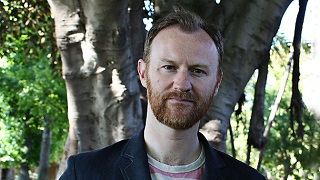De Engelse schrijver, acteur en komiek Mark Gatiss werd geboren op 17 oktober 1966 in Sedgefield. Al in zijn jeugd was Gatiss geïnteresseerd in Arthur Conan Doyles ‘Sherlock Holmes’, de werken van HG Wells en de tv-serie Doctor Who. In 1992 publiceerde hij zijn eerste Doctor Who verhaal “Nightshade”, er volgden er nog drie. Ook schreef hij zijn eerste scenario’s en hoorspelen. Als acteur, werd hij in de Engels sprekende wereld bekend door het komische kwartet The League of Gentlemen, waartoe hij behoort, samen met Reece Shearsmith, Steve Pemberton en Jeremy Dyson. Hun programma won in 1997 de Perrier Award op het Edinburgh Festival Fringe. In hetzelfde jaar ontstond een komische radio-serie, “The League of Gentlemen” en twee jaar later ontstond een tv-serie. In 2005 kwam de film The League of Gentlemen’s Apocalypse als een spin-off van de tv-serie in de bioscopen. In de BBC-miniserie Jekyll speelde hij in 2007 de schrijver Robert Louis Stevenson. Samen met Moffat, ontwikkelde hij het concept van de succesvolle BBC TV-serie Sherlock, waarin ze Arthur Conan Doyle ‘verhalen overbrengen naar de moderne tijd. Naast Benedict Cumberbatch en Martin Freeman speelt hij sinds het begin van de reeks Sherlock Holmes’ broer Mycroft Holmes. Hij werkte ook als uitvoerend producent en schreef eerder voor elk seizoen zijn eigen scenario (The Great Game, De Hond van de Baskervilles en De lege doodskist). Sinds 2014 is Gatiss te zien in de tv-serie Game of Thrones, waarin hij Tycho Nestoris speelt. In verband met Doctor Who en de League of Gentlemen heeft Mark Gatiss verschillende boeken gepubliceerd. In 2004 publiceerde hij de eerste Lucifer Box roman Namens “The Vesuvius Club”.De trilogie werd voortgezet met “The Devil In Amber en eindigde met “Black Butterfly”.
Uit: The Vesuvius Club
“I have always been an appalling judge of character. It is my most beguiling virtue.
What, then, did I make of the Honourable Everard Supple whose likeness I was conjuring on to canvas in my studio that sultry July evening?
He was an imposing cove of sixty-odd, built like a pugilist, who had made a fortune in the diamond mines of the Cape. His declining years, he’d told me during the second sitting – when a client begins to thaw a mite – were to be devoted entirely to pleasure, principally in the gaming houses of the warmer and naughtier parts of Europe. A portrait, in his opinion (and his absence), would be just the thing to hang over the vast baronial fireplace in the vast baronial hall he had recently lavished a hundred thou’ upon.
The Supples, it has to be said, were not amongst the oldest and most distinguished families in the realm. Only one generation back from the Honourable Everard had been the less than honourable Gerald who had prospered only tolerably in a manufactory of leather thumb-braces. Son and heir had done rather better for himself and now to add to the title (of sorts) and the fake coat of arms being busily prepared across town he had his new portrait. This, he told me with a wheezy chuckle, would convey the required air of old-world veracity. And if my painting were any good (that hurt), perhaps I might even be interested in knocking up a few carefully aged canvases of his ancestors?
Supple blinked repeatedly, as was his habit, one lid lingering over his jade-irised glass eye (the left one) as I let myself imagine him tramping into the studio in doublet and hose, all in the name of family honour.
He cleared his throat with a grisly expectoration and I realized he’d been addressing me. I snapped out of my reverie and peeped around the side of the canvas. I’ve been told I peep rather well.”

Mark Gatiss (Sedgefield.17 oktober 1966)
